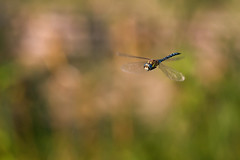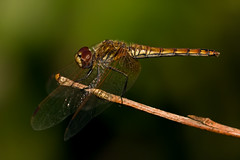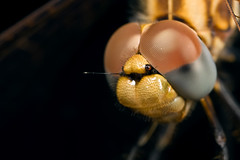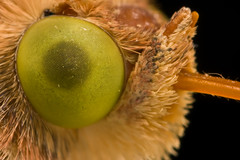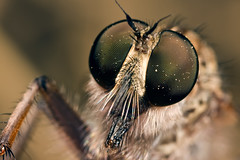Given the choice I’d much rather shoot dragonflies on the ground, but there are some species that always seem to be in motion when I’m out with the camera. After a few attempts at shooting them in flight, and a lot of trial and error, I found a way to take shots of airborne dragons that seems to work pretty well –at least for me ;) Hopefully there will be something in this tutorial that you can use or adapt to your own style of shooting.
I don’t have a high end camera so my 40D only has nine auto focus points. Since I’m into composing with the view finder and will not allow myself to crop there never seems to be a usable auto focus point –the critter is rarely under one of them and the camera is much more likely to lock onto the background. So with the auto focus turned off on a 250mm macro lens (the 180mm L + a 1.4x teleconverter) I set the focus ring on my lens somewhere between the 2 and 5 meter mark –the critter is going to have to be close otherwise it’s going to look too small in the frame. I have the phrase “Clockwise gets close” stuck in my head, since turning the focus ring clockwise will bring the focus point toward me…
I set the camera to manual mode and either F5.6 to F11 depending on how much natural light is in the scene. I want to keep my shutter speed at or higher than 1/640 of a second since I’m hand holding a long lens (forget the 1/focal length rule for this type of shooting –it doesn’t work) and while looking through the lens in the general area where I expect to take the photo I want to see that the light meter is hovering around the -1 EC mark. I’ll adjust the ISO as necessary, but it’s pretty common for me to shoot natural light close-ups at ISO 400. NoiseWare Professional is extremely good at removing sensor noise and preserving detail, and for this type of shot I don’t need to see every lens in the dragon’s compound eye anyway.
Lately I’ve been using a 580EX II camera mounted with a 1/8” grid (to keep from throwing light everywhere) and with a ¼ CTO gel (to warm up the light from the flash). Since I’ve got an 81A warming filter on the lens I can turn what would be a rather harshly lit scene into one that looks more like it was shot in the early morning or late evening. Adjusting the white balance in post does not have the same effect, but if you don’t want to use the warming filter then you might not want to use the CTO either. In post you’ll have two completely different light sources (harsh ambient and warm flash) and there won’t be much that you can do to fix it.
I have the flash in E-TTL mode without any flash exposure compensation and it seems to work really well for subjects that are at least one meter from the front of the lens. Closer than a meter and I’m usually at -1 FEC or more. The reason for using the flash is simple: In post I’m going to raise the exposure and the gridded flash causes the subject to be exposed at a slightly higher level than the background. When I raise the exposure I can keep the background darker relative to the subject and it makes the dragonfly “pop” off of the page. I can also keep the background under exposed a little to keep the colors saturated –so that mid day sun doesn’t look like mid day sun…
Now all I have to do is wait for the dragonfly to get within range and hover, and I can usually tell where to stand by watching its feeding habits. Most insects are creatures of habit and dragonflies are no exception –they’ll get into a pattern of stopping in certain places. Once the critter hovers I quickly course focus the lens by turning the focus rind and then fine tune the focus by slighting moving my body back and forth. I refocus for every shot and I take, and delete, a lot of frames…
In post I raise the exposure, bump the contrast, sharpen the image with Focus Magic (easier to use than USM –less of a chance that I’m going to over sharpen the photo), run NoiseWare to remove sensor noise, adjust the levels to set a black point, add my copyright info to the EXIF data and save the image.
Monday, October 27, 2008
Friday, October 24, 2008
Masters of Macro Interview Series
When I was in university I had the hardest time with my electives. I’d frequently ask my professors “Why do I have to take Chinese Underwater Basket Weaving 101?! It has nothing to do with becoming an Electronics Engineer!” Their sage advice was always “To give you a well rounded education. Now shut up and finish my basket!”. To that end I give you the Masters of Macro Interview Series. Over the next few months I’m going to interview a wide range of photographers in the macro discipline to expose you to many different photographic styles. I’ve often said that the best advice I can give to new shooters is to cherry pick what you see other people doing and add your own style to it. Now’s your chance to do just that from some of the best in macro!
I should have the first interview up in a week –stay tuned…
I should have the first interview up in a week –stay tuned…
Wednesday, October 8, 2008
Shooting Close-ups in Harsh Light
Often I find myself shooting in less than ideal conditions and if I waited for perfect weather or light I’d rarely get a chance to shoot, so one of the things that I wanted to teach myself was how to photograph insects using a mix of natural light and flash. Since portrait photographers often under expose the ambient light in a scene and then use a flash to expose the subject I thought that would be a good place to start. After reading several examples at Strobist (a site that you should all be reading as well) I set out to play. This is what I’ve learned so far…
The trick is to keep the sun at an angle that's either to the side or behind you. The sun is going to be your light source for the background, and the sun + the flash will be your light source for the subject. You want to under expose the background to force the colors to saturate (I'm not shooting in good light) and to use just enough flash to keep the subject from being too dark to see any detail. I shoot in manual mode, and I set the aperture to F8 because it’s usually enough depth for the magnification that I’m shooting at (usually 1/3 life size). I set the ISO high enough to allow me to use a shutter speed of 1/640 of a second or higher –tripods and I just don’t get along. On a few rare occasions I find myself at ISO 800, but for the most part I’m shooting at ISO 400. Don’t worry about noise, since you’re going use noise removal in post (I use NoiseWare Professional because it’s great at removing noise and preserving detail). Since the ambient light in the scene is going to be under exposed you’ll actually have a lot of latitude in how you set up the camera.
I’m currently using an MR-14EX ring flash as my fill light just because I like the quality of the light that I get from it and the balance of that flash –all the weight is back by me. Any diffused light source will work just fine though. Set your flash to manual mode and the power level will depend on the flash you use and the scene that you’re shooting. I have the MR-14EX (on a Canon 180L macro lens) set to 1/32 power most of the time. If you use E-TTL then set the flash to at least -2 FEC.
Once you find a willing subject take a shot and look at the histogram -you don't want to see any blown color channels and the overall exposure should be to the left (dark). Do not use the preview image on the LCD to gage exposure or sharpness -for the most part. For the grape vine that the dragon is perched on in the sample that I’ve included in this tutorial I wanted it to look brown on the preview. If the shade of that vine was too pail then I'd either under expose the ambient more if the background looked too bright (increase the shutter speed), or decrease the power from the flash if the background looked good to me. The image you see on your camera's LCD should look very under exposed. Later when you get the photo on the computer you simply raise the exposure during RAW processing. While watching the histogram increase the exposure, stopping right before one or more color channels blow out. Increasing the contrast will also give you a little more room to increase the exposure.
I then run NoiseWare Professional, adjust the levels to set a black point and shift the grey point, use the auto sharpen option in Elements, and add my copyright to the EXIF data. Save the image as a JPG and I’m done.
The trick is to keep the sun at an angle that's either to the side or behind you. The sun is going to be your light source for the background, and the sun + the flash will be your light source for the subject. You want to under expose the background to force the colors to saturate (I'm not shooting in good light) and to use just enough flash to keep the subject from being too dark to see any detail. I shoot in manual mode, and I set the aperture to F8 because it’s usually enough depth for the magnification that I’m shooting at (usually 1/3 life size). I set the ISO high enough to allow me to use a shutter speed of 1/640 of a second or higher –tripods and I just don’t get along. On a few rare occasions I find myself at ISO 800, but for the most part I’m shooting at ISO 400. Don’t worry about noise, since you’re going use noise removal in post (I use NoiseWare Professional because it’s great at removing noise and preserving detail). Since the ambient light in the scene is going to be under exposed you’ll actually have a lot of latitude in how you set up the camera.
I’m currently using an MR-14EX ring flash as my fill light just because I like the quality of the light that I get from it and the balance of that flash –all the weight is back by me. Any diffused light source will work just fine though. Set your flash to manual mode and the power level will depend on the flash you use and the scene that you’re shooting. I have the MR-14EX (on a Canon 180L macro lens) set to 1/32 power most of the time. If you use E-TTL then set the flash to at least -2 FEC.
Once you find a willing subject take a shot and look at the histogram -you don't want to see any blown color channels and the overall exposure should be to the left (dark). Do not use the preview image on the LCD to gage exposure or sharpness -for the most part. For the grape vine that the dragon is perched on in the sample that I’ve included in this tutorial I wanted it to look brown on the preview. If the shade of that vine was too pail then I'd either under expose the ambient more if the background looked too bright (increase the shutter speed), or decrease the power from the flash if the background looked good to me. The image you see on your camera's LCD should look very under exposed. Later when you get the photo on the computer you simply raise the exposure during RAW processing. While watching the histogram increase the exposure, stopping right before one or more color channels blow out. Increasing the contrast will also give you a little more room to increase the exposure.
I then run NoiseWare Professional, adjust the levels to set a black point and shift the grey point, use the auto sharpen option in Elements, and add my copyright to the EXIF data. Save the image as a JPG and I’m done.
Saturday, September 27, 2008
Macro Q&A: What lens?
koauke writes,
"Hi, I was admiring your macro work and was wondering if I could ask you a question. I'd like to get a macro lens for my Canon XSi (450D) and was wondering if you could give me some advice. Would the Canon 100mm macro be better for insect photography than the 60mm EF-S?"
Here's my responce: In my humble opinion there is no such thing as a bug lens -it's the insect and your ability to get close that will determin if you get the shot and not the working distance of the lens. Having said that I think that lenses in the 100mm range are easier to use for a beginner since there is less of a chance that you are going to cast a shadow over the insect and scare it off. But if you watch the angles that you shoot from the EF-S 60mm is actually a better lens.
The image I've included with this post was taken with the EF-S 60mm + a 250D closeup and an 81A warming filter in natural light (no flash).
Until next time happy shooting :)
"Hi, I was admiring your macro work and was wondering if I could ask you a question. I'd like to get a macro lens for my Canon XSi (450D) and was wondering if you could give me some advice. Would the Canon 100mm macro be better for insect photography than the 60mm EF-S?"
Here's my responce: In my humble opinion there is no such thing as a bug lens -it's the insect and your ability to get close that will determin if you get the shot and not the working distance of the lens. Having said that I think that lenses in the 100mm range are easier to use for a beginner since there is less of a chance that you are going to cast a shadow over the insect and scare it off. But if you watch the angles that you shoot from the EF-S 60mm is actually a better lens.
The image I've included with this post was taken with the EF-S 60mm + a 250D closeup and an 81A warming filter in natural light (no flash).
Until next time happy shooting :)
Friday, September 26, 2008
Canon 40D Light Meter Error Example
The small image to the right in this post is the same critter that I'm posting as an example of the 40D's light metering problem when using the MT-24EX. I had to bring the exposure down 2/3 of a stop, so it was possible to recover the shot.
This next photo is the same critter and the exact same scene, but this image is more than two stops over exposed:

Keep in mind that I had the FEC on the MT-24EX set to -2/3 (via the 40D). The exposure wasn't just off because I set it wrong, it varied by two stops for the same scene. To make matters even more interesting is that I can change the 40D from Evaluative E-TTL mode to Average E-TTL mode and the way the 40D exposes a shot with MT-24EX won't change -and that tels me that the MT-24EX is not operating in Evaluative E-TTL mode when connected to the 40D -a problem I never had when shooting with the Xti...
Canon you really need to fix the metering system in the 40D because until you do I can't recommend any of your newer cameras because they could have the same problem. I'm not the only one who's had issues with the 40D and the MT-24 -see this thread at DPR or this post at Fred Miranda ...
This next photo is the same critter and the exact same scene, but this image is more than two stops over exposed:

Keep in mind that I had the FEC on the MT-24EX set to -2/3 (via the 40D). The exposure wasn't just off because I set it wrong, it varied by two stops for the same scene. To make matters even more interesting is that I can change the 40D from Evaluative E-TTL mode to Average E-TTL mode and the way the 40D exposes a shot with MT-24EX won't change -and that tels me that the MT-24EX is not operating in Evaluative E-TTL mode when connected to the 40D -a problem I never had when shooting with the Xti...
Canon you really need to fix the metering system in the 40D because until you do I can't recommend any of your newer cameras because they could have the same problem. I'm not the only one who's had issues with the 40D and the MT-24 -see this thread at DPR or this post at Fred Miranda ...
Sunday, September 21, 2008
Technique
Recently over at the Fred Miranda Macro Forum we were having a friendly discussion about which macro lens is best -and granted, we all know that it's the photographer who makes the image and not the gear. But I couldn't help putting my .02 in for the Canon MPE-65mm macro lens as well as add a few photos to the thread and the original poster had this to say:
“Very nice...I wonder, were these insects glued in place or dead from the freezer?, because I dought the working distance of the MPE 65mm is more than a couple of inches at best and I know how hard it is to capture shy bugs with a lens barrel looming up close to them...”
This was my response:
A fair question. I never shoot dead insects, but I do study the behavior of live critters so I can take advantage of their quirks to get close. With bees I get most of my photos in the early spring when the temperatures are low and the sun dips behind the clouds (the bees need the heat to drive their metabolism)...
5x

...or after it rains (notice the wet hair)...
2x

...or early in the morning when it's still cool...
2x
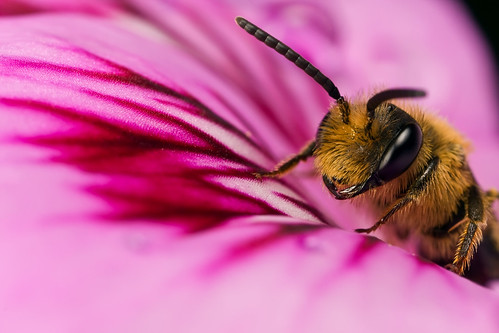
...and they are covered in dew...
2x
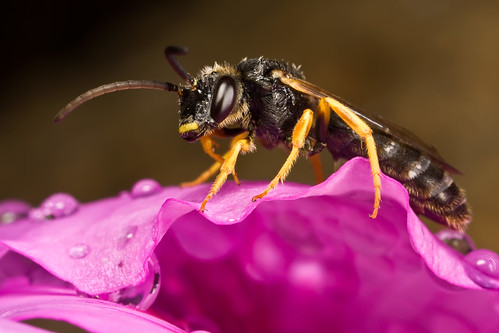
...sometimes they'll even crawl onto your hand to get warm...
2x
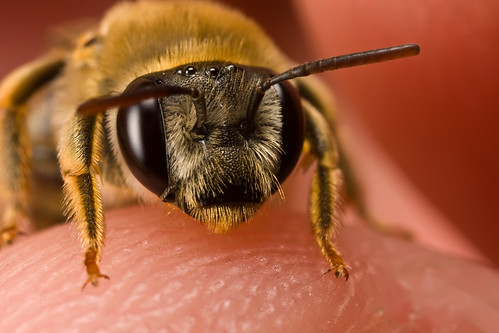
...or shoot late in the day when they have perched for the night (this one is sleeping and I'm holding onto the twig)...
2.5x
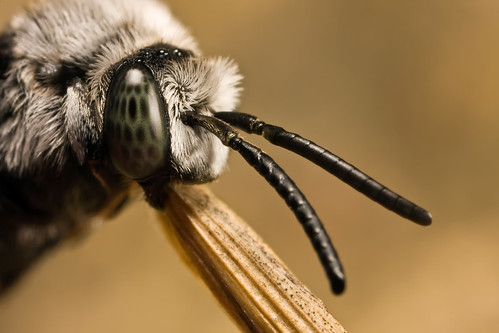
...you can even shoot very timid insects when it's windy since they would rather deal with you than the wind...
2x
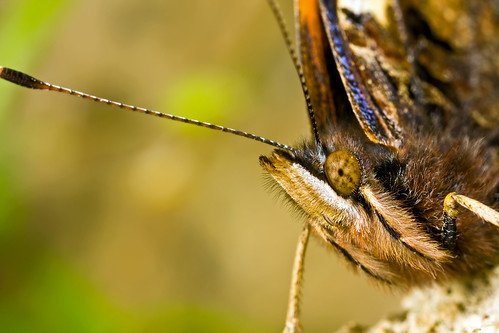
...so you see there really is no such thing as a "bug lens" and that having a short working distance actually allows me to get photos that I wouldn't be able to take with longer glass...
“Very nice...I wonder, were these insects glued in place or dead from the freezer?, because I dought the working distance of the MPE 65mm is more than a couple of inches at best and I know how hard it is to capture shy bugs with a lens barrel looming up close to them...”
This was my response:
A fair question. I never shoot dead insects, but I do study the behavior of live critters so I can take advantage of their quirks to get close. With bees I get most of my photos in the early spring when the temperatures are low and the sun dips behind the clouds (the bees need the heat to drive their metabolism)...
5x

...or after it rains (notice the wet hair)...
2x

...or early in the morning when it's still cool...
2x

...and they are covered in dew...
2x

...sometimes they'll even crawl onto your hand to get warm...
2x

...or shoot late in the day when they have perched for the night (this one is sleeping and I'm holding onto the twig)...
2.5x

...you can even shoot very timid insects when it's windy since they would rather deal with you than the wind...
2x

...so you see there really is no such thing as a "bug lens" and that having a short working distance actually allows me to get photos that I wouldn't be able to take with longer glass...
Sunday, September 14, 2008
40D and the MT-24EX Flash Metering Problem
Early this year I switched from using Canon’s Xti to the 40D and at the same time I was working on getting better diffusion from the MT-24EX. Oddly enough I was having exposure problems with the 40D that I never saw with the Xti: Scenes that the Xti would normally under expose by 1/3 of a stop the 40D would over expose by that same 1/3 of a stop or more. If I took six frames of a scene none of them would be exposed the same and they’d all be over exposed even though it’s normal for me to shoot with the MT-24EX set to -2/3 FEC.
Even shooting against something reflective would give me over exposures even though the camera should have under exposed. At first I thought the 40D was “hyper accurate” and that there was something wrong either with my technique or the diffuser materials that I had used on the twin flashes but as time passed I read more and more people make the same claim –the MT-24EX just doesn’t work well when attached to the 40D. The problem will manifest itself the most when you are shooting a subject when there is very little in the background for the flash to reflect off of –if the background is black in the final image then odds are the subject is completely blown (a problem that I never had with the Xti).
SteB, one of the posters at DP Review mentioned having the same exposure problem that I was seeing and that it seemed like the MT-24EX was operating in Average E-TTL mode instead of Evaluative. Sure enough switching the 40D to Average E-TTL mode seems to give the same exposures as Evaluative in my informal field testing. The work around that I eventually come up with is to make sure that the flash heads were pointed right at the scene I was shooting and to keep one flash head off centered from the top of the lens at the 11 O’clock position and place the other at 2 O’clock (relative to me). The angle of the heads depends on what you’re using for a diffuser –currently I’m using a pair of Sto-Fens over a piece of diffuser plastic that only blocks 2% of the light coming out of the flash. So I position the heads one click up from all the way down at life size and all the way down toward the lens for 2x to 5x shooting. The image included with this post is the result of an entire macro season of trial and error trying to solve the metering problem and get good light quality at the same time…
I’m still not getting consistent exposures, but it’s better than putting one of the flash heads at the very top of the MPE-65mm: It seems like one side of the subject gets thrown into too much shadow so the light meter over compensates for it –badly. If you see some insects with two sets of eyes and eight sets of wings it’s my fault cause the MT-24EX pumped out so much power it altered the critter’s genetics…
I contacted Canon on this issue and they responded to me very quickly –but their solution was for me to send all of my kit into a Canon service center. Unless they test my rig against the same scenes I shoot then they’re not going to see the problem and besides it not just a problem with my camera or flash…
So here's what I need you to do: If you shoot macro with the 40D and the MT-24EX then please respond to this thread at DPR or this post at Fred Miranda and tell me if you are getting consistent exposures or not. If you are then please tell me a little about your technique and the types of scenes you shoot. If enough people post then maybe we can get Canon to take a serious look at the 40D's light meter...
Even shooting against something reflective would give me over exposures even though the camera should have under exposed. At first I thought the 40D was “hyper accurate” and that there was something wrong either with my technique or the diffuser materials that I had used on the twin flashes but as time passed I read more and more people make the same claim –the MT-24EX just doesn’t work well when attached to the 40D. The problem will manifest itself the most when you are shooting a subject when there is very little in the background for the flash to reflect off of –if the background is black in the final image then odds are the subject is completely blown (a problem that I never had with the Xti).
SteB, one of the posters at DP Review mentioned having the same exposure problem that I was seeing and that it seemed like the MT-24EX was operating in Average E-TTL mode instead of Evaluative. Sure enough switching the 40D to Average E-TTL mode seems to give the same exposures as Evaluative in my informal field testing. The work around that I eventually come up with is to make sure that the flash heads were pointed right at the scene I was shooting and to keep one flash head off centered from the top of the lens at the 11 O’clock position and place the other at 2 O’clock (relative to me). The angle of the heads depends on what you’re using for a diffuser –currently I’m using a pair of Sto-Fens over a piece of diffuser plastic that only blocks 2% of the light coming out of the flash. So I position the heads one click up from all the way down at life size and all the way down toward the lens for 2x to 5x shooting. The image included with this post is the result of an entire macro season of trial and error trying to solve the metering problem and get good light quality at the same time…
I’m still not getting consistent exposures, but it’s better than putting one of the flash heads at the very top of the MPE-65mm: It seems like one side of the subject gets thrown into too much shadow so the light meter over compensates for it –badly. If you see some insects with two sets of eyes and eight sets of wings it’s my fault cause the MT-24EX pumped out so much power it altered the critter’s genetics…
I contacted Canon on this issue and they responded to me very quickly –but their solution was for me to send all of my kit into a Canon service center. Unless they test my rig against the same scenes I shoot then they’re not going to see the problem and besides it not just a problem with my camera or flash…
So here's what I need you to do: If you shoot macro with the 40D and the MT-24EX then please respond to this thread at DPR or this post at Fred Miranda and tell me if you are getting consistent exposures or not. If you are then please tell me a little about your technique and the types of scenes you shoot. If enough people post then maybe we can get Canon to take a serious look at the 40D's light meter...
Subscribe to:
Posts (Atom)

